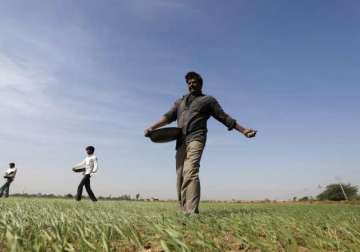Doubling farmers' income by 2022 will prove Herculean
New Delhi: After adjusting for rising costs, an Indian farmerÂ’s income effectively rose 5 percent per year over the decade (2003-2013), according to an IndiaSpend analysis of various government data. This calls into question Finance
New Delhi: After adjusting for rising costs, an Indian farmerÂ’s income effectively rose 5 percent per year over the decade (2003-2013), according to an IndiaSpend analysis of various government data. This calls into question Finance Minister Arun JaitleyÂ’s declaration of doubling their income over the next five years.
"We are grateful to our farmers for being the backbone of the country's food security. We need to think beyond food security and give back to our farmers a sense of income security," Jaitley had said in budget in February. "Government will, therefore, reorient its interventions in the farm and non-farm sectors to double the income of the farmers by 2022."
But doubling of real incomes would be “a miracle of miracles” as it would imply a compound growth rate of 12 percent per annum, Ashok Gulati, former chairman of Commission for Agricultural Costs and Prices and Professor, Indian Council for Research on International Economic Relations, wrote in the Indian Express.
The average monthly income from raising crops and rearing animals increased from Rs.1,060 in 2003 to Rs.3,844 in 2013, according to the report Situational Assessment of Agricultural Households by the National Sample Survey Organisation, a compounded annual income growth rate of 13.7 percent.
The 2003 report considered only land-owning farmers, while the 2013 report considered all the agricultural households, including landless labourers, we will consider only incomes from cultivation and rearing animals.
To double the income of farmers by 2022, in nominal (numerical) terms-which do not take inflation into account-would require a 15% annual income growth rate (compounded), according to IndiaSpend estimates.
So, the government would seemingly have to ensure a marginal increase in the rate of income growth-keeping business as usual-from 13.7 percent to 15 percent per year to deliver on the promise of doubling farmer income.
However, there are four hurdles:
- Increasing input costs, such as seeds, fertilisers and irrigation
- irrelevance of minimum support price, which the government pays farmers when it buys their crops
- Absence of market infrastructure, such as warehouses and cold storages, and
- The fact that 85 percent of farmers do not benefit from insurance.
Unless these issues are addressed, a farmerÂ’s income will only double nominally. Real income in 2022, adjusted for inflation and increased expenditure, will still be close to 2016 income, according to this report by Devinder Sharma, an eminent food and trade policy analyst.
Profit margins of farmers are declining because of dropping farm productivity and a rise in input costs. While income from cultivation in 2013 became 3.6 times that in 2003, input costs tripled in the same period, almost nullifying the effect of tripling income.
Does it help any longer that government buys harvests?
Started in 1965, the Minimum Support Price (MSP) is a system of artificial pricing that attempts to ensure just remuneration to farmers. The Commission for Agricultural Costs and Prices (CACP) fixes the MSP of procurement for 23 agricultural items produced in India.
While the announcement of increases in MSP should act as an encouragement to farmers when they sow, three factors do not let this happen: There is very low awareness about MSP -- less than 25 percent of farmers on an average, while for some crops, less than 5 percent -- know about MSP.
Over the last three years, the MSP for all crops increased from up to 12 percent per year, compared with up to 42 percent in 2012-13, up to 53 percent in 2011-12, and up to 39 percent in 2010-11.
MSP increases can fuel inflation-and, so, higher monthly expenses-in urban areas. The MSP for ragi (finger millet) was hiked 52 percent in 2008-09, for tur dal (pigeon pea) 52 percent in 2010-11, for rapeseed/mustard 35 percent in 2011-12, and for jowar 53 percent in 2012-13.
Farmers get as little as 10 percent of the final price. Efficient agricultural markets can also be a potent tool for poverty reduction, noted this 2012 Reserve Bank of India report.
Farmers do not get remunerative prices due to the limited reach of MSP -- less than 25 percent farmers know about MSP -- and an agricultural marketing system that delivers only a small fraction (10-30 percent of the retail price, according to this Business Standard report) of the price to the farmer, said this NITI Aayog report.
Regulatory barriers have constrained investments in agriculture markets and lowered capacity of farmers to be domestically and internationally competitive. Multiplicity of taxes under Agriculture Produce and Marketing Committee laws in various states have undermined interests of farmers and benefitted middlemen, said the NITI Aayog report.
Moreover, only 19 million -- or 15 percent - Indian farmers benefitted from crop insurance schemes announced by the government in 2014-15. As many as 37.2 million farmers were covered under the three schemes-National Agricultural Insurance Scheme, Modified National Agricultural Insurance Scheme and Weather Based Crop Insurance Scheme -- but only half of them benefitted from it.
Half of those who did not use insurance were unaware of crop insurance, the NSS report said. Pradhan Mantri Fasal Bima Yojana (Prime MinisterÂ’s Crop Insurance Scheme), the latest government initiative, merges existing insurance schemes, reduces the premium to be paid by farmers and removes the limit on government subsidy to insurance.
“China started off reforms with agriculture in 1978, and during 1978-84, agriculture GDP (gross domestic product) increased by more than 7 percent per year and farm incomes by more than 14 percent per year due to deregulation of prices, halving poverty in just six years,” Ashok Gulati wrote in this research paper.
With agricultural GDP in India growing 1 percent in 2015-16 (advance estimate), it will not be easy to increase individual farm incomes 14 percent per year.
